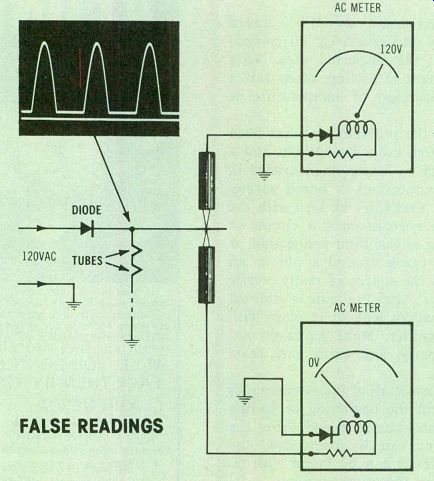By Wayne Lemons, CET
A dim, narrow, out-of-focus and unstable picture was on the TV receiver screen. During some initial tests, the technician noticed the tube cathodes didn't seem to glow as brightly as usual. The tube heaters were series-connected and the 21LU8 socket was easy to reach, so the tech measured the ac voltage across those heater pins.
About 22 volts ac was the VOM reading.
As that was a normal reading, he went on to other tests. After some time, the technician decided to check the heater voltage a second time. This time the meter indicated zero volts. The meter was not defective or intermittent; it measured the line voltage correctly and was not erratic.
After a few minutes of perplexity over the TV problem and the mysterious meter readings, the technician thought of the answer to both.
DC versus AC
This TV had an instant-on circuit which, when the power was switched off, connected a diode in series with the tube heaters to keep them warm at half voltage. There fore, all heaters were to be supplied with ac voltage when the power switch was on, or with half-wave unfiltered dc voltage during power-off operation.
When he first measured the heater voltage, the tech (correctly) used the ac-voltage function because the power was turned on. In that VOM, a single series-connected diode rectifies the ac by passing only one peak, and the range resistor is chosen so the meter accurately reads the RMS value of the ac voltages.
A double on/off switch was used in this TV model. When turned on, one section applied ac to the low-voltage power supply. The other section shorted across the heater diode to restore proper heater voltage.
The diode-shorting section was open, therefore, the TV had normal B+ voltages but only half the usual heater voltage. The original TV symptoms were caused by the low heater voltage, not by weak tubes.
Meter polarity
The diagram shows both possible connections for testing the heater voltage at the diode cathode. With the leads connected as shown by the top VOM, both diodes had the same polarity, and the current path was not changed significantly. Normally, the meter operated only from the positive peak of any ac voltage. Therefore, it provided the same reading for the positive half-wave dc as it did for ac.
When the technician reversed the meter leads (which is permissible with ac), the two diodes (see bottom VOM diagram) had opposing polarities, thus opening the current path and giving a zero reading.

---------- FALSE READINGS
Other readings
There are possibilities for wrong readings with other meters or conditions. If the tech had used the VOM jack that adds a coupling capacitor (for checking ac in an ac/dc mixture), both polarities of meter probes would have provided low readings of the half-wave dc heater voltage. Also, a VTVM would have given a low reading of the half-wave dc voltage, regardless of the polarity.
Also see: